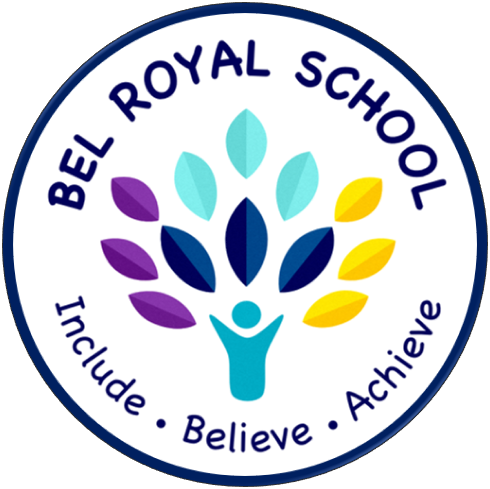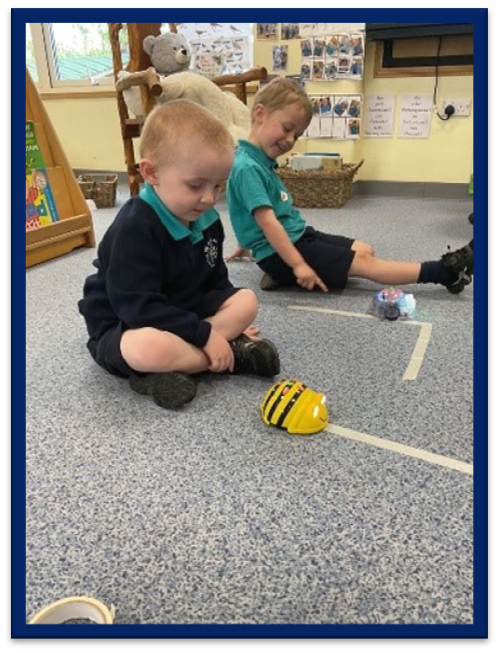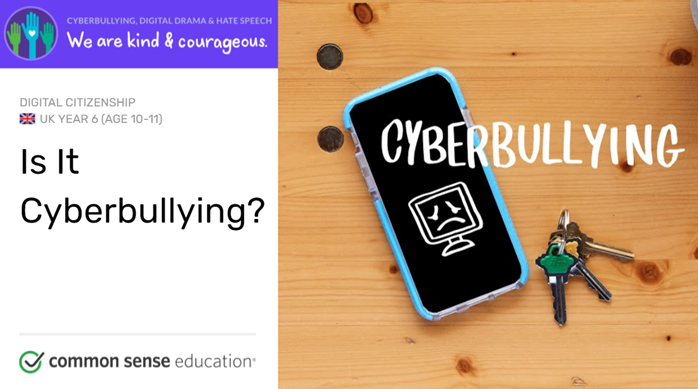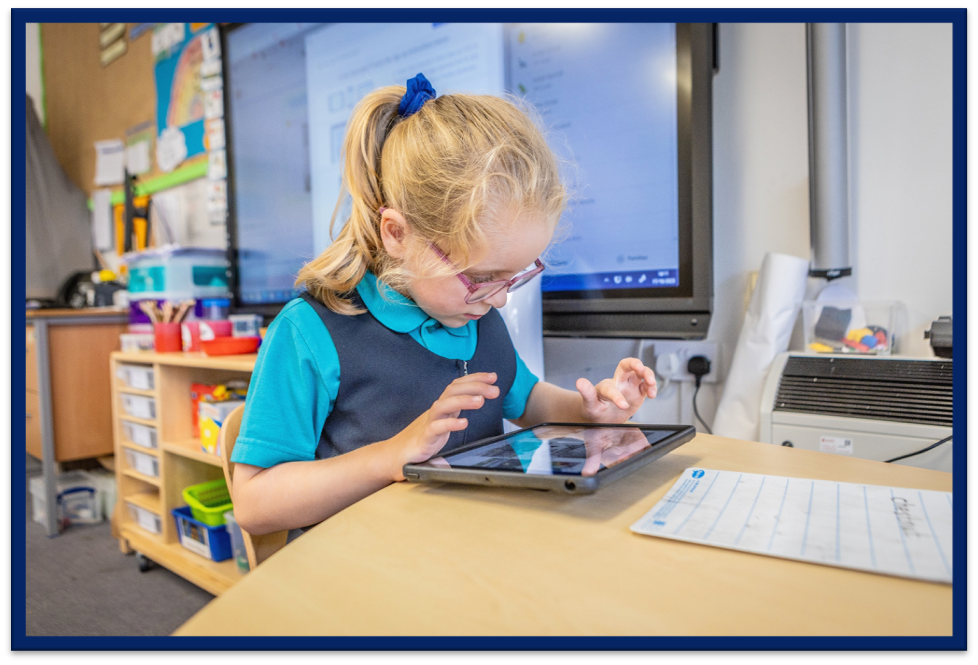
Bel Royal Primary School
Computing
Investing in tomorrow’s technology today is more critical than ever.
Bill Gates

Intent
A high-quality computing education equips pupils to use computational thinking and creativity to understand and change the world. Computing has deep links with mathematics, science, and design and technology, and provides insights into both natural and artificial systems.
The core of computing is computer science, in which pupils are taught the principles of information and computation, how digital systems work, and how to put this knowledge to use through programming. Building on this knowledge and understanding, it ensures pupils are equipped to use information technology to create programs, systems and a range of content.
Computing also ensures that pupils become digitally literate – able to use and express themselves and develop their ideas through information and communication technology – safely at a level suitable for the future workplace and as active participants in a digital world.
Computing at Bel Royal School intends to develop ‘thinkers of the future’ through a modern, ambitious and relevant education in computing. We want to equip pupils to use computational thinking and creativity that will enable them to become active participants in the digital world. It is important to us that children understand how to use the ever-changing technology to express themselves, as tools for learning and as a means to drive their generation forward into the future.
Whilst ensuring they understand the advantages and disadvantages associated with online experiences, we want children to develop as respectful, responsible and confident users of technology, aware of measures that can be taken to keep themselves and others safe online.
Our aim is to provide a computing curriculum that is designed to balance acquiring broad and deep knowledge alongside opportunities to apply skills in various digital contexts. Beyond teaching computing discreetly, we will give pupils the opportunity to apply and develop what they have learnt across wider learning in the curriculum.
The computing curriculum aims to:
-
Encourage creative use of technology in learning
-
Inspire pupils to be creative and innovative
-
Ensure that pupils use technology routinely and discerningly to search for reliable sources of information, collaborate and publish their work
-
Help pupils to learn to validate reliable sources of information, synthesise information, communicate, collaborate and problem-solve using the opportunities that technology provides.
-
Develop the wider skills required in the workplace, such as creativity and business acumen and how to use and apply new knowledge and skills to problem-solving
-
Educate and empower students to use technology safely and responsibly, both in school and in all aspects of their social lives regarding their future reputations.
and aims to ensure that all pupils:
-
Can understand and apply the fundamental principles and concepts of computer science, including abstraction, logic, algorithms and data representation.
-
Can analyse problems in computational terms, and have repeated practical experience of writing computer programs to solve such problems.
-
Can evaluate and apply information technology, including new or unfamiliar technologies, analytically to solve problems
-
Are responsible, competent, confident and creative users of information and communication technology
Implementation
Computing is integrated across and within all subject areas but is also taught discretely.
Throughout school, your child will use Seesaw to view and share learning and communicate electronically with their teacher and you at home. In Key Stage 2, your child will use tools like Google Suite and Office 365 to communicate, create and share documents.
Our scheme of work for Computing is adapted from the ‘Teach Computing’ Curriculum and covers all aspects of the Jersey Curriculum. This scheme was chosen as it has been created by subject experts and is based on the latest pedagogical research. It provides an innovative progression framework where computing content (concepts, knowledge, skills and objectives) and aims to equip young people with the knowledge, skills and understanding they need to thrive in the digital world of today and the future. The curriculum can be broken down into 3 strands: computer science, information technology and digital literacy, with the aims of the curriculum reflecting this distinction.
Most importantly, we want our pupils to use computing responsibly and safely. We take online safety very seriously, and we aim to give children the necessary skills to keep themselves safe online. Children have a right to enjoy childhood online, to access safe online spaces and to benefit from all the opportunities that a connected world can bring them, appropriate to their age and stage.
Regular lessons cover all aspects of online safety using the Project Evolve – Education for a Connected World’ framework to build children’s online resilience. The framework aims to support and broaden the provision of online safety education, so that it is empowering, builds resilience and affects positive cultural change. The objectives promote the development of safe and appropriate long-term behaviours, and support educators in shaping the culture within their setting and beyond.
Within each year group topics include -

-
Self Image and Identity - This strand explores the differences between online and offline identity, beginning with self-awareness, shaping online identities and media influence in propagating stereotypes. It identifies effective routes for reporting and support and explores the impact of online technologies on self-image and behaviour.
-
Online Relationships - This strand explores how technology shapes communication styles and identifies strategies for positive relationships in online communities. It offers opportunities to discuss relationships, respecting, giving and denying consent and behaviours that may lead to harm and how positive online interaction can empower and amplify your voice.
-
Online Reputation - This strand explores the concept of reputation and how others may use online information to make judgements. It offers opportunities to develop strategies to manage personal digital content effectively and capitalise on technology’s capacity to create effective positive profiles.
-
Online Bullying - This strand explores bullying and other online aggression and how technology impacts those issues. It offers strategies for effective reporting and intervention and considers how bullying and other aggressive behaviour relate to legislation.
-
Managing Online information - This strand explores how online information is found, viewed and interpreted. It offers strategies for effective searching, critical evaluation of data, the recognition of risks and the management of online threats and challenges. It explores how online threats can pose risks to our physical safety as well as online safety. It also covers learning relevant to ethical publishing.
-
Health Well-being and Lifestyle - This strand explores the impact that technology has on health, well-being and lifestyle, e.g. mood, sleep, body health and relationships. It also includes understanding negative behaviours and issues amplified and sustained by online technologies and the strategies for dealing with them.
-
Privacy and Security - This strand explores how personal online information can be used, stored, processed and shared. It offers both behavioural and technical strategies to limit the impact on privacy and protect data and systems against compromise.
-
Copyright and Ownership - This strand explores the concept of ownership of online content. It explores strategies for protecting personal content and crediting the rights of others as well as addressing potential consequences of illegal access, download and distribution.

This Framework is supplemented using the Commonsense Education Scheme, providing further resources and links to digital literacy. The activities empower learners to think critically, behave safely, and participate responsibly in our digital world - 21st-century skills which are essential for children and young people to harness the full potential of technology for learning.
Pupils are taught to be aware of risks and how to protect themselves. All members of the school community must sign up to an ‘Acceptable Use Policy’ and this is reviewed regularly. Pupils in Year 3 and upwards have school email addresses and pupils have access to filtered internet sites. Internet safety is paramount and is closely monitored by both the school and the Government of Jersey.
To help with our implementation of the computing curriculum, many programmes and apps will be used that enable us to introduce pupils to word processing, data handling, simulations, data logging, spreadsheets and control technology and to enhance their learning across the curriculum.
We have a variety of hardware available to all teachers, including:
-
1 to 1 iPads for all children
-
A class set of laptops
-
Desktops for shared use in the library
-
Coding kits
-
Active Boards in every classroom
-
Class set of Microbits
-
Spike Lego Kits
-
Visualisers
Impact
Pupils at Key Stage 1 should be taught to:
-
Understand what algorithms are; how they are implemented as programs on digital devices; and that programs execute by following precise and unambiguous instructions.
-
Create and debug simple programs.
-
Use logical reasoning to predict the behaviour of simple programs.
-
Use technology purposefully to create, organise, store, manipulate and retrieve digital content.
-
Recognise common uses of information technology beyond school use.
-
Use technology safely and respectfully, keeping personal information private; identify where to go for help and support when they have concerns about content or contact on the Internet or other online technologies.
Pupils at Key Stage 2 should be taught to:
-
Design, write and debug programs that accomplish specific goals, including controlling or simulating physical systems; solving problems by decomposing them into smaller parts.
-
Use sequence, selection, and repetition in programs; work with variables and various forms of input and output.
-
Use logical reasoning to explain how some simple algorithms work and to detect and correct errors in algorithms and programs.
-
Understand how computer networks, including the Internet, work; how they can provide multiple services, such as the World Wide Web; and the opportunities they offer for communication and collaboration.
-
Use search technologies effectively; appreciate how results are selected and ranked, and be discerning in evaluating digital content.
-
Select, use and combine a variety of software (including Internet services) on a range of digital devices to design and create a range of programs, systems and content that accomplish given goals, including collecting, analysing, evaluating and presenting data and information.
-
Use technology safely, respectfully and responsibly; recognise acceptable/unacceptable behaviour; identify a range of ways to report concerns about content and contact.
